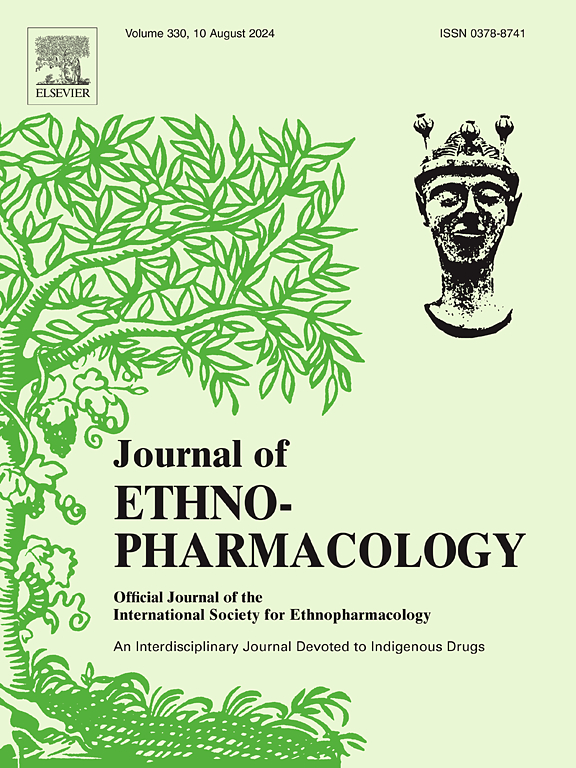Ardisia Crispae Radix et Rhizoma: A review of botany, traditional uses, phytochemistry, pharmacology, and toxicology
IF 4.8
2区 医学
Q1 CHEMISTRY, MEDICINAL
引用次数: 0
Abstract
Ethnopharmacological relevance
Ardisia Crispae Radix et Rhizoma comprises three primary source plants: Ardisia crenata Sims, Ardisia crispa (Thunb.) A. DC., and Ardisia crenata Sims var. bicolor (Walk) C. Y. Wu et C. Chen. These species are prevalent in mid-to-low-latitude regions and are traditionally utilized as herbal medicines in East Asia and India. They have demonstrated notable efficacy in anti-inflammatory properties and possess potential anti-tumor, antimicrobial, antioxidant, and anti-angiogenic activities.
Aim
This review systematically evaluated the botany, traditional uses, phytochemistry, pharmacology, and toxicity of Ardisia Crispae Radix et Rhizoma to assist future innovative research and facilitate the development of new therapeutic agents.
Materials and methods
Literature was sourced from both library and electronic databases, including Web of Science, PubMed, Elsevier, Google Scholar, and CNKI. The review focuses on phytochemistry, pharmacological research, and toxicity studies related to Ardisia Crispae Radix et Rhizoma.
Results
Ardisia Crispae Radix et Rhizoma is traditionally used to treat inflammation and injuries. Current pharmacological studies suggest its potential anti-tumor, anti-inflammatory, antimicrobial, antioxidant, and anti-angiogenic activities. This review identified approximately 161 compounds in Ardisia Crispae Radix et Rhizoma, such as saponins, flavonoids, coumarins, essential oils, lignans, and terpenes.
Conclusions
Ardisia Crispae Radix et Rhizoma is a promising medicinal plant resource with a diverse range of specialized metabolites. However, existing research predominately addresses phytochemistry and pharmacological activities, with limited exploration of underlying mechanisms. Further systematic evaluations of its efficacy and clinical safety are required.

Ardisia Crispae Radix et Rhizoma:植物学、传统用途、植物化学、药理学和毒理学综述。
民族药理学意义:Ardisia Crispae Radix et Rhizoma 由三种主要来源植物组成:Ardisia crenata Sims、Ardisia crispa (Thunb.) A. DC.和 Ardisia crenata Sims var.这些物种盛产于中低纬度地区,在东亚和印度传统上被用作草药。目的:本综述系统地评估了旱金莲的植物学、传统用途、植物化学、药理学和毒性,以协助未来的创新研究,促进新治疗药物的开发:文献来源于图书馆和电子数据库,包括 Web of Science、PubMed、Elsevier、Google Scholar 和 CNKI。综述的重点是与旱莲草相关的植物化学、药理研究和毒性研究:结果:旱莲草传统上用于治疗炎症和损伤。目前的药理研究表明,它具有潜在的抗肿瘤、抗炎、抗菌、抗氧化和抗血管生成活性。本综述确定了 Ardisia Crispae Radix et Rhizoma 中的约 161 种化合物,如皂苷、黄酮类、香豆素、精油、木脂素和萜类:Ardisia Crispae Radix et Rhizoma 是一种前景广阔的药用植物资源,具有多种特殊代谢产物。然而,现有研究主要针对植物化学和药理活性,对其潜在机制的探索有限。需要对其疗效和临床安全性进行进一步的系统评估。
本文章由计算机程序翻译,如有差异,请以英文原文为准。
求助全文
约1分钟内获得全文
求助全文
来源期刊

Journal of ethnopharmacology
医学-全科医学与补充医学
CiteScore
10.30
自引率
5.60%
发文量
967
审稿时长
77 days
期刊介绍:
The Journal of Ethnopharmacology is dedicated to the exchange of information and understandings about people''s use of plants, fungi, animals, microorganisms and minerals and their biological and pharmacological effects based on the principles established through international conventions. Early people confronted with illness and disease, discovered a wealth of useful therapeutic agents in the plant and animal kingdoms. The empirical knowledge of these medicinal substances and their toxic potential was passed on by oral tradition and sometimes recorded in herbals and other texts on materia medica. Many valuable drugs of today (e.g., atropine, ephedrine, tubocurarine, digoxin, reserpine) came into use through the study of indigenous remedies. Chemists continue to use plant-derived drugs (e.g., morphine, taxol, physostigmine, quinidine, emetine) as prototypes in their attempts to develop more effective and less toxic medicinals.
 求助内容:
求助内容: 应助结果提醒方式:
应助结果提醒方式:


